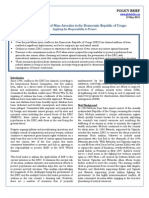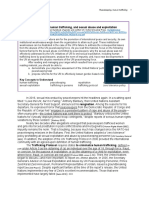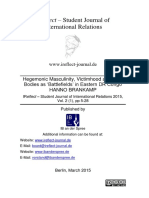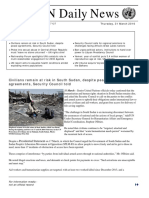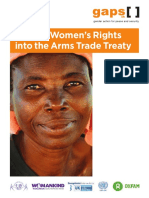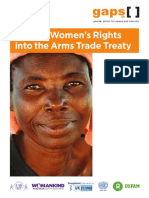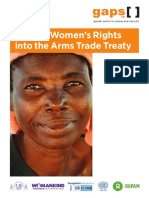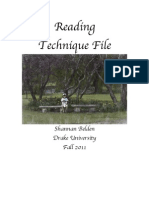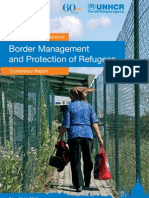Democratic Republic of Congo: An In-Depth Look at Human Rights Violations Drake University Shannan Belden
Democratic Republic of Congo: An In-Depth Look at Human Rights Violations Drake University Shannan Belden
Uploaded by
ShannanmcleesebeldenCopyright:
Available Formats
Democratic Republic of Congo: An In-Depth Look at Human Rights Violations Drake University Shannan Belden
Democratic Republic of Congo: An In-Depth Look at Human Rights Violations Drake University Shannan Belden
Uploaded by
ShannanmcleesebeldenOriginal Title
Copyright
Available Formats
Share this document
Did you find this document useful?
Is this content inappropriate?
Copyright:
Available Formats
Democratic Republic of Congo: An In-Depth Look at Human Rights Violations Drake University Shannan Belden
Democratic Republic of Congo: An In-Depth Look at Human Rights Violations Drake University Shannan Belden
Uploaded by
ShannanmcleesebeldenCopyright:
Available Formats
Belden
Photos from EPAFs training course in Congo: Ofelia de Pablo/Javier Zurita
Democratic Republic of Congo: An In-depth Look at Human Rights Violations Drake University Shannan Belden
Belden
Introduction Over the course of the 20th Century, countless occurrences of human rights violations took place. The response after each atrocity was typically to declare Never Again, by the international community. It happened after the Holocaust, Rwanda and Darfur, and yet today serious human rights violations are taking place all over the world. Men, women and children are being tortured, raped, abducted and forced into labor all over the world in senseless wars with no end in sight. The focus of this paper is to analyze the human rights violations committed in the Democratic Republic of Congo (DRC) over the last 15 years and how the United Nations and other organizations have responded to these violations. In order to accomplish this analysis four things must be considered: the history of the conflict within the Congo, the United Nations role and authority of its peacekeeping mission in the Congo, the roles of the Human Rights Watch and the Office of the High Commissioner on Human Rights in trying to combat human rights violations in the Congo and, how effective these organizations have been in fighting against human rights violations in the DRC including what factors have helped or hindered their fight.
Belden
Background on the Conflict in the DRC The conflict within the Democratic Republic of Congo goes all the way back to the 1960s when they gained their independence from Belgium. The country has a vastly diverse group of ethnic people in an area with enormous natural wealth, which adds up to lots of conflict. The country has struggled to maintain some sense of stability through dictatorship and democracy. In the 1990s, a series of wars brought the conflicts in the DRC to the attention of the United Nations. The first of these wars started in 1996. Neighboring states invaded the DRC and replaced President Mobutu with Laurent Kabila in 1997 (Sinclair & Tortolani, 2011). In 1998, after a fallout between Kabila and his foreign supporters, neighboring states, Rwanda and Uganda, attempted to invade Kinshasa, the capitol of the DRC, and overthrow Kabila. The attempted invasion of Kinshasa failed due to the DRC receiving unexpected assistance from troops sent by Zimbabwe, Angola and Namibia (United States State Department, 2011). Rwandan and Ugandan troops retreated to the Eastern and Northeastern part of the DRC and took control. In the summer of 1999, the three groups agreed to a ceasefire and signed the Lusaka Ceasefire Agreement (Sinclair & Tortolani, 2011). In 2001, Laurent Kabila was assassinated; his son, Joseph Kabila, replaced him. Joseph Kabila has proved more willing to The
Belden
work with the UN, bringing more freedom for political activities and bringing about economic reform. The one thing his reforms havent changed is all the human rights violations taking place in Eastern Congo (United States State Department, 2011).
Human Rights Violation in the DRC Human rights violations in the DRC, which are approaching the number of human rights violations committed during the Holocaust, are mainly centered in the Northeastern part of the country. The area has several different ethnic groups that live in the area including mainly: Bantou, Sudanese, Nilotic and Pygmee (van Puijenbroek, 2008). The largest conflict in the area is between the Hema people, part of the Nilotic ethnic family, and the Lendu, part of the Bantou ethnic family. The Lendu are farmers and need the land for farming whereas the Hema are more of a military people and this is where the conflict comes in. The Hema see themselves as superiors to the Lendu and conflict between the two tribes has occurred off and on for a century (van Puijenbroek, 2008). The scale of human rights violations taking part in this area of the DRC is atrocious. UNICEF reported approximately 37,000 victims of sexual violence in 2007 alone (Lututala, 2010). The violence has caused a forced migration with over almost 3.5 million people being displaced. The Army and the
Belden
police dont protect the people and in fact are the main perpetrators of the human rights violations being committed! Citizens are fleeing their homes to avoid being victims of sexual violence, forced into combat, forced into labor or falsely accused of crimes and thrown into prison. They witness their homes being burned and have their belongings stolen so many have nothing (Lututala, 2010). Sexual violence is the most common abuse committed in the area. The rate of sexual violence appears to be higher in the DRC than in any other conflict. One report found that 2 in 5 women and 1 in 4 men were victims of sexual violence in the DRC (Melhado, 2010). A majority of those men and women felt that the attacks were related to the conflict in the area. There is a common belief that rape and sexual violence is being used as a weapon of war. Rape can loosely be defined as a weapon because it is used to dominate, instill fear, humiliate, and destroy communities or ethnic groups (Maedl, 2011). Even though other parts of the DRC have become stabile, there are still many, small, militia groups in the Eastern part of the country. It isnt just these militia groups that are committing these terrible acts; the Army and the police are also taking part in the violation of human rights. One study interviewed victims of sexual crimes at a hospital in Eastern Congo. They found that many women and men
Belden
were not just attacked but many had been abducted and gang raped, some were held for long periods of time and used as sex slaves (Maedl, 2011). The number of victims is outstanding. The study stated between 2005-2007 there were almost 40,000 victims, of which 33% were children (Maedl, 2011). Those numbers include only those victims who reported the crimes against them. Many victims dont report the crime either because they are unable to get to a hospital or they fear the consequences of admitting that he or she is a victim. Another report claims the numbers are as high as 80% of women have been victims of rape in most any community in this area, calling it a plague of epidemic proportions (Duroch, McRae, & Grais, 2011)! The human rights violations have a long reaching and long lasting effect on the communities and victims. It not only destroys individuals but also families and communities, as well as the economic capacities of those communities (Maedl, 2011). Many women wont report the crime because they fear being abandoned by their spouse, which is a common consequence of rape, or turned away from their families and communities. Others dont report violations because there isnt much faith in getting justice for the crime. There is no protection offered for victims who testify against their attacker, often times the criminals are given minimum sentences or they are able to escape from prison. Of the 1221 cases that the Human Rights Office
Belden
brought before the court, only 374 were actually convicted (United Nations, 2009). Victims of sexual violence in the DRC get victimized again after the crime happens. Victims of sexual violence tend to suffer from depression, posttraumatic stress disorder and even substance abuse. Another upsetting consequence many women have to deal with is pregnancy resulting from the rape (Bartels et al., 2010). Many victims also have to deal with contracting sexually transmitted infections or even HIV/AIDS. The impacts of these consequences are lessened if women seek medical attention immediately after the rape.
United Nations Involvement Security Council Resolution 1279 (1999) authorized what would become phase one of the peace-keeping mission in the DRC, which was know as MONUC. It was issued and started in November of 1999. It was a small mission that was planned to last 3 months and the goal of the mission was to observe and help with implementing the Lusaka Ceasefire Agreement. Unfortunately, the conflict wasnt even close to ending with the Lusaka Ceasefire. The Northeast territories of the DRC contained many militia groups, both foreign and domestic. Due to conflict between these militia groups, phase one of the peacekeeping mission turned into phase two, which allowed UN
Belden
troops to help support government national unity and elections. Security Council Resolution 1291 (2000) authorized phase two of MONUC. Phase two was considered successful so the mission moved into phase three. Security Council Resolution 1376 (2001) authorized phase three of MONUC, which focused on helping to stabilize the areas in Eastern Congo. In May 2010, according to Security Council Resolution 1925, the UN peacekeeping mission in the DRC was reorganized and renamed MONUSCO. It is considered phase four of the mission and is set to last twelve months. The goal of this phase of the mission is to focus on protecting civilians with the plan of ultimately pulling the UN troops out of the DRC. With the extent of human rights violations that have been committed in the DRC in the last 15 years, this is an extremely optimistic and somewhat unrealistic goal for the final phase of the United Nations peacekeeping mission in the Democratic Republic of Congo! The role of the United Nations involvement in the DRC over the years has changed its focus. At the start, MONUC was mainly an observation mission, which then turned into a support mission. The goals of these missions were met with a great amount of success. The UN has successfully monitored the ceasefires, helped establish truces, assisted with the elections and helped stabilize democratic rule (United Nations, 2009).
Belden
Unfortunately, the instability in the Eastern part of the DRC has made it necessary for the UN to remain in the DRC. The UNs mission in the DRC changed in order to keep inline with the Security Council Resolution 1820 (2008) to include protection of the citizens in the DRC. The mission needed to focus on protecting the men, women and children whose human rights were being violated in the Eastern DRC. One example of an operation that was somewhat successful was UN Operation Artemis. Ugandan troops withdrew and were replaced by fewer French troops. Shortly after the French troops took over, fighting started in Bunia between two ethnic tribes. Eventually more troops were sent in to replace the French troops and the conflict died down (van Puijenbroek, 2008). In 2005 a Disarmament, Demobilization and Reintegration (DDR) Program began. The goal of the program was to disarm, demobilize and reintegrate combatants. This program was able to demobilize over 30,000 combatants, of which a third were children. Unfortunately, they were only able to collect an average of .5 firearms per combatant even though it was believed there was an average of 1 or more firearms available to each combatant. Another unfortunate outcome of the program was that only about 20% of the ex-combatants were able to find another source of income.
Belden 10
The UN faces a number of problems in stabilizing the Eastern part of DRC. The biggest issue is that the current government is very weak outside of the area where it is located. The DRC is a very large land area and the current government has difficulty in controlling outlying areas making it easier for militia groups to attack those areas, particularly the East. Another major problem the government faces are the continual land disputes in the East, particularly between the Hema and Lendu tribes. The government also faces issues with rebels and corruption making it difficult to stabilize the entire country (United Nations, 2009). The UN is trying to find a way to end the human rights violations while empowering the citizens, military and government in order to withdraw from the DRC. The government of the DRC has been very cooperative with the UN but they would also like to see the UN withdraw so the DRC can stand on its own. In order to accomplish this goal, the UN is working with the government, military and citizens through various organizations in order to set up the necessary infrastructure. One way the UN is working with citizens and the military is assisting them in setting up ways to distribute humanitarian aid. They have also created a Sexual and Gender Based Violence Unit that will work with the Congolese authorities to develop special police units, establish legal support for victims,
Belden 11
increase knowledge in judicial matters and to increase police patrolling of areas where women are at the highest risk of being attacked (United Nations, 2009). Joint protection teams have also been established through the coordination of MONUC. These joint teams along with local NGOs such as the Haki na Amani network, a network of Catholic and Protestant churches, and other local NGOs are helping the community to develop programs to try and eliminate these atrocious crimes against citizens. One program that they have started puts trainers in the community to help the community learn how to resolve conflict in non-violent ways as well as assisting with reconciliation. They also offer citizens information on womens rights and human rights (van Puijenbroek, 2008). These groups have also helped communities implement an early warning system to warn of conflict and give citizens an opportunity to flee before being victimized. The have also helped communities organize security meetings where they have the opportunity to discuss their concerns about security as well as choose community delegates or leaders (van Puijenbroek, 2008). Even with all that the UN is trying to accomplish, attacks continue and even seem to be increasing. The UNs response to this is that it is the rebel groups, many of whom were
Belden 12
responsible for the Rwandan Genocide. Unfortunately, that isnt completely true. Human rights violations are not only being committed by rebels but also the military and the police; there have even been reports that UN peacekeepers are committing some of these crimes. The Secretary-General has declared a zero tolerance policy on abuse and created the Conduct and Discipline Unit (CDU). This unit was created to monitor peacekeepers. The unit is in charge of training military and civilian peacekeepers in conduct and ensuring they are aware of the rules and regulations such as curfew and areas that are off limits (United Nations, 2009). Since MONUC was reorganized and became MONUSCO, the UN is working with the UN Joint Human Right Office (UNJHRO) to try to put and end to the human rights violations that are still occurring at an alarming rate in Eastern DRC. In 2011, sexual violence against women is still occurring on a regular basis, as well as cruel inhuman treatment, abductions, lootings and burning of houses. It is still just as difficult for victims to identify the perpetrators of the abuse and the abuse continues to be committed by rebels, the police and the Army (United Nations, 2011). The UNJHRO continues to investigate human rights violations because of their strong belief that the Universal Declaration of Human Right, which was ratified by the DRC, protects human
Belden 13
rights. The UNJHRO believe the Congolese government as well as MONUSCO need to be doing more to protect the citizens from these violations of their human rights (United Nations, 2011).
UN Human Rights Partners During the UN World Conference on Human Rights, it was suggested that the UN create an office for a UN High Commissioner for Human Rights. Several months later the office was created and its main responsibility is to investigate human rights violations and report to the UN on these violations (Kennedy, 2006). The OHCHR doesnt have much power to actually change the situation. Through its investigations, it recognizes the violations against the human rights of the citizens of the DRC and condemns the massacres that have occurred. The OHCHR urges in its reports that all parties do a better job at protecting the citizens from the rebels. It also urges the Congolese Government to become stricter on its own military and make a stronger effort of prosecuting those who violate human rights (OHCHR, 2003). The Human Rights Watch has also paid careful attention to the human rights violations occurring in the DRC. They have put out many reports condemning the Congolese forces and MONUC for their inability to protect Congolese citizens. In one report, they give an example on the attack of Kiwanja. In this
Belden 14
particular conflict, MONUC was supposed to work with the Congolese forces to help protect citizens in the area. The Congolese Army was hostile with MONUC and even instigated violence against MONUC (Human Rights Watch, 2008). Human Rights Watch has reported for over a decade that the Congolese forces are unable to protect their citizens. The UN peacekeepers arent doing such a great job at protecting the Congolese citizens either. The DRC may be stabilized throughout most of the country; however, the East remains unstable. Rebels are still causing conflict, invading villages, accusing citizens of working for other rebel groups, and kidnapping, torturing, raping and executing Congolese citizens (Human Rights Watch, 2008)!
Effectiveness of the UN and their Partners MONUC has had many successes in the DRC, especially with phase one and phase two. They successfully assisted with keeping the peace during the ceasefires and stabilizing the government enough to have elections. Operation Artemis, which oversaw the French troops replacing Ugandan troops in Eastern Congo, is considered a success for MONUC (van Puijenbroek, 2008). MONUC also established the Sexual and Gender Based Violence Unit, which has worked with the Congolese to set up police units to help stop the human rights violations. In addition, this unit
Belden 15
helps set up legal support for Congolese victims as well as helping to increase judicial knowledge (United Nations, 2009). MONUC has also had some success working with local organizations, such as Haki na Amani. Haki na Amani is a network of Catholic and Protestant churches that have worked together and with the Congolese citizens to set up early warning systems that enable citizens to seek safety when violence breaks out. Haki na Amani has also helped citizens set up local security meetings to discuss security problems and has sent in trainers to teach people how to solve conflicts without violence (van Puijenbroek, 2008). These programs have been successful in helping citizens work together to try to end the violence. Even with all the successes that MONUC and other organizations have had, the fact remains that when it comes to Human rights violation, the failures exceed the successes. The Disarmament, Demobilization and Reintegration Program is one program that is considered a failure. The program was unable to recover a significant amount of weapons and it was not able to help most of the ex-combatants find legal work in order to successfully reintegrate. The fact that human rights violations are still being committed at an alarming rate, and some of these violations have been committed by UN peacekeepers, is also a serious failure. Money and manpower has been used to create units to oversee peacekeepers so they dont commit these
Belden 16
violations; the need for units like these is appalling (United Nations, 2009). The OHCHR and the Human Rights Watch continue to put out reports on the human rights violations being committed in the DRC. They criticize the UN for not doing enough to stop the violations. The reports help bring these issues to light but other than that they dont do anything to help stop the violations being committed, including offering viable suggestions on how to stop the violations. The UN, local organizations and citizens are working hard to try and end the human rights violations that continue to happen in the DRC. There are several factors that hinder the efforts to end these violations. The biggest factor is that neither the UN, nor the DRC government have been successful at controlling the rebel groups that are in the East. These rebel groups are likely responsible for a major portion of violations that are committed. Another factor that hinders the success of stopping the violations is that many violations are not reported. The risks of reporting often outweigh the benefit, especially when you factor in the poor criminal justice system in the country. Most of the time, the police are unable to accurately determine who committed the crimes. Even when they do identify the criminal, the jails do a poor job of holding them and many escape.
Belden 17
The last factor that hinders the success of ending the human rights violations in the DRC is the lack of government accountability. The Army and the police continue to commit violations and the government is not doing enough to control these groups. These groups need stricter regulations and when they commit violations the government needs to do more to bring them to justice.
Conclusion The United Nations mission in the DRC has been a success as far as a peacekeeping mission goes. It has worked with the Congolese government to bring peace and stability to most of the country. Unfortunately, the mission to end human rights violations has been much less successful. The biggest obstacle to this mission is the rebel troops who remain and hold power in the Eastern part of the country. If it werent for these rebel groups, it is likely that the Congolese Army and police force would not be able to violate human rights as easily. With so many different armed groups in the area, it is difficult for victims to be able to accurately accuse their abusers. The Congolese government is ready for the UN to withdraw and wants the opportunity to handle the situation on its own. Considering the poor job that the government has been doing up
Belden 18
to this point in protecting its citizens, it would be a bad idea for UN troops to withdraw from the DRC anytime in the near future.
Belden 19
References Bartels, S., Scott, J., Leaning, J., Mukwege, D., Lipton, R., & VanRooyen, M. (2010). Surviving sexual violence in eastern Democratic Republic of Congo Retrieved from http://find.galegroup.com.cowlesproxy.drake.edu/gic/infomark.do?&contentSet=IACDocuments&idigest=8b4f5c18b21409583272658ff128480b&type=retrieve&tabID=T00 2&prodId=GIC&docId=A247222962&source=gale&userGroupName=drakeu_main&versio n=1.0 Duroch, F., McRae, M., & Grais, R. F. (2011). Description and consequences of sexual violence in Ituri province, Democratic Republic of Congo. BMC International Health & Human Rights, 11(1), 5-12. doi:10.1186/1472-698X11-5 Human Rights Watch. (2008). Killings in Kiwanja. New York, NY: Human Rights Watch. Retrieved from http://www.hrw.org Kennedy, Paul. (2006). Parliament of Man. New York, NY: Random House. Lututala, B. M. (2010). The role of governance and research. Forced Migration Review, (36), 8-9. Retrieved from http://search.ebscohost.com.cowlesproxy.drake.edu/login.aspx?direct=true&db=a9h&AN=56660485&site=ehost-live Maedl, A. (2011). Rape as weapon of war in the eastern DRC? the victims' perspective. Human Rights Quarterly, 33(1), 128-147. Retrieved from http://search.ebscohost.com.cowlesproxy.drake.edu/login.aspx?direct=true&db=a9h&AN=59507761&site=ehost-live Melhado, L. (2010). Rates of sexual violence are high in Democratic Republic of the Congo. International Perspectives on Sexual & Reproductive Health, 36(4), 210-210. Retrieved from http://search.ebscohost.com.cowlesproxy.drake.edu/login.aspx?direct=true&db=a9h&AN=58771178&site=ehost-live
Belden 20
Office of the High Commissioner for Human Rights. (2003). Commission on human rights resolution 2003/15. Geneva, Switzerland: OHCHR. Retrieved from http://ap.ohchr.org/documents/sdpage_e.aspx?b=1&c=51&t=11 Sinclair, A. M., & Tortolani, B. C. (Eds.). (2011). Annual Review of Global Peace Operations 2011. Boulder, CO: Lynne Rienner Publishers. United Nations. (1999). Security Council Resolution 1279. New York, NY: United Nations. Retrieved from http://www.un.org/documents/scres.htm United Nations. (2000). Security Council Resolution 1291. New York, NY: United Nations. Retrieved from http://www.un.org/documents/scres.htm United Nations. (2001). Security Council Resolution 1376. New York, NY: United Nations. Retrieved from http://www.un.org/documents/scres.htm United Nations. (2008). Security Council Resolution 1820. New York, NY: United Nations. Retrieved from http://www.un.org/documents/scres.htm United Nations. (2009). MONUC Briefing Materials. New York, NY: United Nations. Retrieved from http://www.un.org/en/peacekeeping/missions/monuc/resources.shtml United Nations. (2010). Security Council Resolution 1925. New York, NY: United Nations. Retrieved from http://www.un.org/documents/scres.htm United Nations. (2011). MONUSCO. New York, NY: United Nations. Retrieved from http://monusco.unmissions.org/ United States State Department. (2011, Sept. 30). Background note: Democratic Republic of Congo. Retrieved from http://www.state.gov/r/pa/ei/bgn/2823.htm
Belden 21
van Puijenbroek, J. (2008). Human security from below, a case study from the Ituri district, Democratic Republic of Congo. Security & Human Rights, 19(1), 45-53. Retrieved from http://search.ebscohost.com.cowlesproxy.drake.edu/login.aspx?direct=true&db=a9h&AN=35176005&site=ehost-live
You might also like
- Care Giver Interview QuestionsDocument11 pagesCare Giver Interview QuestionsTendency BeretuNo ratings yet
- Combating Bad-Faith Litigation Tactics With Claims For Abuse of Process SpohnDocument9 pagesCombating Bad-Faith Litigation Tactics With Claims For Abuse of Process SpohnCésar E. Moreno More100% (2)
- ThesisDocument38 pagesThesisJD VergaraNo ratings yet
- Juvenile Delinquency and Crime PreventionDocument217 pagesJuvenile Delinquency and Crime Preventionella sakuraNo ratings yet
- Tackling The Threat of Mass Atrocities in The Democratic Republic of The CongoDocument6 pagesTackling The Threat of Mass Atrocities in The Democratic Republic of The Congocberger1215No ratings yet
- Rape As Weapon War 1 2012Document14 pagesRape As Weapon War 1 2012Mersed BarakovicNo ratings yet
- DRC MAR - July 7 - GFDocument31 pagesDRC MAR - July 7 - GFInterActionNo ratings yet
- Deconstructing LubangaDocument22 pagesDeconstructing LubangaIELTSNo ratings yet
- The Interrelationship Between Rape and Constructions of Masculinity and Development Assistance in The DemocraticDocument17 pagesThe Interrelationship Between Rape and Constructions of Masculinity and Development Assistance in The DemocraticGlobal Research and Development Services100% (1)
- 5.2011 1 Phyllis English 2Document12 pages5.2011 1 Phyllis English 2XimonsNo ratings yet
- DRC Blog Post, FINAL, by Sabrina NelsonDocument5 pagesDRC Blog Post, FINAL, by Sabrina NelsonbillbergmailNo ratings yet
- Lay Judge JanuaryDocument331 pagesLay Judge Januaryjmanu9997No ratings yet
- Letter To The Prime Minister of Canada About The Human Rights Situation in The DRC & Protest Decision To Participate in 2012 Francophonie SummitDocument7 pagesLetter To The Prime Minister of Canada About The Human Rights Situation in The DRC & Protest Decision To Participate in 2012 Francophonie SummitLorraine M. ThompsonNo ratings yet
- 10 Facts You Should Know About The Crisis in The DRCDocument21 pages10 Facts You Should Know About The Crisis in The DRCWandaNo ratings yet
- ENGW 103 Final PaperDocument11 pagesENGW 103 Final PaperAdam BehnkeNo ratings yet
- 33 1 MaedlDocument21 pages33 1 Maedlapi-252594969No ratings yet
- ProposalDocument18 pagesProposalThulasivanthana UdhayashankarNo ratings yet
- Meaning:: "Political Instability Is Described As A Condition of A Country Where ADocument83 pagesMeaning:: "Political Instability Is Described As A Condition of A Country Where APratyush KukrejaNo ratings yet
- Ciamun'24 Research Report - HRC - Erika Khov The Act of Silent Genocide in CongoDocument16 pagesCiamun'24 Research Report - HRC - Erika Khov The Act of Silent Genocide in CongospamkimyongNo ratings yet
- Final GenocideDocument6 pagesFinal Genocideapi-356163933No ratings yet
- Program On Human Trafficking and Forced LaborDocument16 pagesProgram On Human Trafficking and Forced LaborGlobal Justice AcademyNo ratings yet
- Trafficking in Women and ChildrenDocument5 pagesTrafficking in Women and ChildrenSrinivas LaishettyNo ratings yet
- The ASF and UN Offensive MandatesDocument12 pagesThe ASF and UN Offensive MandatesadsNo ratings yet
- Côte D’Ivoire: Ethnic Nepotism Under Alassane Dramane OuattaraFrom EverandCôte D’Ivoire: Ethnic Nepotism Under Alassane Dramane OuattaraNo ratings yet
- South Sudan EssayDocument7 pagesSouth Sudan Essayapi-286700408No ratings yet
- International Human Rights Law and Sexual Violence Against Men in Conflict ZonesDocument25 pagesInternational Human Rights Law and Sexual Violence Against Men in Conflict ZonesUsman GhaniNo ratings yet
- Group 48 Newsletter - January 2015Document8 pagesGroup 48 Newsletter - January 2015Joanne LauNo ratings yet
- Dying For Action: Decision Time For An Urgent, Effective Arms Trade TreatyDocument14 pagesDying For Action: Decision Time For An Urgent, Effective Arms Trade TreatyOxfamNo ratings yet
- 1.0 Background of The Study: Chapter OneDocument33 pages1.0 Background of The Study: Chapter Oneokewunmi Afeez olaideNo ratings yet
- Lessons From Rwanda - 3Document1 pageLessons From Rwanda - 3RwandaEmbassyBerlinNo ratings yet
- Great Lake Refugee Crisis-GradedDocument19 pagesGreat Lake Refugee Crisis-GradedGangadhar BhawareNo ratings yet
- Genocidein The PhilippinesDocument3 pagesGenocidein The PhilippinesAlexa GeronimoNo ratings yet
- CivicsDocument11 pagesCivicsNatnael BelaynehNo ratings yet
- Peacekeeping, Human Trafficking, and Sexual Abuse1Document8 pagesPeacekeeping, Human Trafficking, and Sexual Abuse1Eevee CatNo ratings yet
- Journal 2Document9 pagesJournal 2cieytieyNo ratings yet
- Human TraffickingDocument13 pagesHuman Traffickingapi-312630116No ratings yet
- Hegemonic Masculinity, Victimhood and Male Bodies As Battlefields' in Eastern DR CongoDocument25 pagesHegemonic Masculinity, Victimhood and Male Bodies As Battlefields' in Eastern DR CongoQobul ImronNo ratings yet
- Stolen ChildhoodDocument4 pagesStolen ChildhoodalumniupcNo ratings yet
- Duty To Protect: Intent To Destroy in Whole or in PartDocument4 pagesDuty To Protect: Intent To Destroy in Whole or in PartShasha AzizNo ratings yet
- Alaniz On Honduras SettlementsDocument20 pagesAlaniz On Honduras SettlementsTeresaNo ratings yet
- DRC Pol219-3Document12 pagesDRC Pol219-3api-386941208No ratings yet
- Conflict Resolution - Assignment 1 ReportDocument10 pagesConflict Resolution - Assignment 1 ReportAlexander BozinovNo ratings yet
- Agenda TopicsDocument4 pagesAgenda Topicsapi-387574009No ratings yet
- Group 48 Newsletter - April 2013Document10 pagesGroup 48 Newsletter - April 2013Joanne LauNo ratings yet
- UN Daily News: in The HeadlinesDocument8 pagesUN Daily News: in The HeadlinesAdilaNo ratings yet
- General Assembly: United NationsDocument22 pagesGeneral Assembly: United Nationsprashantsinghal10No ratings yet
- Un Mapping Report DRC 2010 SummaryDocument4 pagesUn Mapping Report DRC 2010 SummaryKARIUKI KINUTHIANo ratings yet
- Achievements of The United NationsDocument6 pagesAchievements of The United NationsSwastika072No ratings yet
- Dissertation Politics of GenocideDocument60 pagesDissertation Politics of GenocideFlo_articlesNo ratings yet
- Imbusch Misse & Carrión Violence Research in Latina America A Literature ReviewDocument68 pagesImbusch Misse & Carrión Violence Research in Latina America A Literature ReviewIvan PojomovskyNo ratings yet
- Are LGBT Rights Human RightsDocument5 pagesAre LGBT Rights Human RightsSachin PatelNo ratings yet
- Sec17 - 2011 - FABB - Policy Brief - DRCDocument2 pagesSec17 - 2011 - FABB - Policy Brief - DRCInterActionNo ratings yet
- Putting Women's Rights Into The Arms Trade TreatyDocument22 pagesPutting Women's Rights Into The Arms Trade TreatyOxfamNo ratings yet
- Putting Women's Rights Into The Arms Trade TreatyDocument22 pagesPutting Women's Rights Into The Arms Trade TreatyOxfam100% (1)
- Putting Women's Rights Into The Arms Trade TreatyDocument22 pagesPutting Women's Rights Into The Arms Trade TreatyOxfamNo ratings yet
- Putting Women's Rights Into The Arms Trade TreatyDocument22 pagesPutting Women's Rights Into The Arms Trade TreatyOxfamNo ratings yet
- Putting Women's Rights Into The Arms Trade TreatyDocument22 pagesPutting Women's Rights Into The Arms Trade TreatyOxfamNo ratings yet
- Putting Women's Rights Into The Arms Trade TreatyDocument22 pagesPutting Women's Rights Into The Arms Trade TreatyOxfamNo ratings yet
- Putting Women's Rights Into The Arms Trade TreatyDocument22 pagesPutting Women's Rights Into The Arms Trade TreatyOxfamNo ratings yet
- Putting Women's Rights Into The Arms Trade TreatyDocument22 pagesPutting Women's Rights Into The Arms Trade TreatyOxfamNo ratings yet
- Putting Women's Rights Into The Arms Trade TreatyDocument22 pagesPutting Women's Rights Into The Arms Trade TreatyOxfamNo ratings yet
- Putting Women's Rights Into The Arms Trade TreatyDocument22 pagesPutting Women's Rights Into The Arms Trade TreatyOxfamNo ratings yet
- Putting Women's Rights Into The Arms Trade TreatyDocument22 pagesPutting Women's Rights Into The Arms Trade TreatyOxfamNo ratings yet
- SS Shannan Belden Formal ResumeDocument2 pagesSS Shannan Belden Formal ResumeShannanmcleesebeldenNo ratings yet
- Reading Technique File: Shannan Belden Drake University Fall 2011Document12 pagesReading Technique File: Shannan Belden Drake University Fall 2011ShannanmcleesebeldenNo ratings yet
- SS Shannan Belden Formal ResumeDocument2 pagesSS Shannan Belden Formal ResumeShannanmcleesebeldenNo ratings yet
- Shannan McCleese Belden ResumeDocument2 pagesShannan McCleese Belden ResumeShannanmcleesebeldenNo ratings yet
- Syllabus SPLDocument5 pagesSyllabus SPLvn wnstnNo ratings yet
- Outlinetopic and Sentence PDFDocument2 pagesOutlinetopic and Sentence PDFWati KaNo ratings yet
- Preboard 1-50Document9 pagesPreboard 1-50Mishia Renee EchonNo ratings yet
- Children and Youth Services Review: Amy Dworsky, Mark E. CourtneyDocument6 pagesChildren and Youth Services Review: Amy Dworsky, Mark E. CourtneyRamsey MusallamNo ratings yet
- A Critical Approach On Nick JoaquinDocument6 pagesA Critical Approach On Nick JoaquinRachel Ann Olis100% (1)
- South Asian Review of The Commercial Sexual Exploitation of Children-Pakistan StudyDocument46 pagesSouth Asian Review of The Commercial Sexual Exploitation of Children-Pakistan StudyMustafa Nazir Ahmad100% (1)
- European Convention On Human Rights PDFDocument2 pagesEuropean Convention On Human Rights PDFJoshNo ratings yet
- 12 Core FunctionsDocument14 pages12 Core Functionszaelany jr100% (1)
- Abstract Bullying in Elementary SchoolDocument1 pageAbstract Bullying in Elementary SchoolPutri FebyNo ratings yet
- Interview With Steve McQueenDocument5 pagesInterview With Steve McQueenKittyojr0% (1)
- Border Management and Protection of Refugees: Trans-Regional ConferenceDocument77 pagesBorder Management and Protection of Refugees: Trans-Regional ConferenceCiobanu Igor100% (1)
- Case Assignment #2Document5 pagesCase Assignment #2aykeem.youngbloodNo ratings yet
- Ulbricht Sentencing Defense LetterDocument13 pagesUlbricht Sentencing Defense LetterAndy GreenbergNo ratings yet
- Script-GAD SeminarDocument2 pagesScript-GAD SeminarJHAN MARK LOGENIONo ratings yet
- Free Press 9/9/11Document24 pagesFree Press 9/9/11Donna S. SeayNo ratings yet
- Introduction Child AbuseDocument14 pagesIntroduction Child AbuseSyaminAzharNo ratings yet
- Ernest Kurtz - Bill W. Takes LSD - 1Document13 pagesErnest Kurtz - Bill W. Takes LSD - 1Carey PickardNo ratings yet
- How To Recognize Verbal Abuse and BullyingDocument14 pagesHow To Recognize Verbal Abuse and BullyingSergio Daúde PortucalenseNo ratings yet
- Othello Study Guide QuestionsDocument7 pagesOthello Study Guide QuestionsJoanne AdamsNo ratings yet
- Online Immigrant Visa and Alien Registration Application (DS-260)Document11 pagesOnline Immigrant Visa and Alien Registration Application (DS-260)Cherrylyn Cachola100% (1)
- CHILD LABOUR by OjasveeDocument2 pagesCHILD LABOUR by OjasveeNikhil MishraNo ratings yet
- Republic Act No. 11188 - Special Protection of Children in SituationsDocument23 pagesRepublic Act No. 11188 - Special Protection of Children in Situationsms aNo ratings yet
- Ekkehard Eggs : Logos, Ethos and Pathos in Order To Persuade. On The Other Hand, HoweverDocument50 pagesEkkehard Eggs : Logos, Ethos and Pathos in Order To Persuade. On The Other Hand, HoweverBaldomero RuizNo ratings yet
- Parents Code of ConductDocument5 pagesParents Code of Conductjeremy chewNo ratings yet
- Legal SeparationDocument12 pagesLegal SeparationBenitez Gherold100% (1)
- Letter From The Solicitors of PC Stuart Mann of Dyfed Powys PoliceDocument4 pagesLetter From The Solicitors of PC Stuart Mann of Dyfed Powys PoliceJonathan Bishop100% (1)




